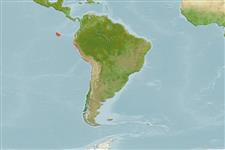>
Eupercaria/misc (Various families in series Eupercaria) >
Haemulidae (Grunts) > Haemulinae
Etymology: Anisotremus: Greek, anisos = unequal + Greek, trema, -atos = hole (Ref. 45335).
Environment: milieu / climate zone / depth range / distribution range
Écologie
marin récifal; profondeur 3 - 30 m (Ref. 5227), usually 3 - 12 m (Ref. 5227). Tropical; 1°N - 24°S, 92°W - 70°W
Eastern Pacific: De Manta, Ecuador to Antofagasta, Chile.
Taille / Poids / Âge
Maturity: Lm ? range ? - ? cm
Max length : 58.0 cm TL mâle / non sexé; (Ref. 122662); poids max. publié: 896.00 g (Ref. 53696)
Forms schools in open water above rocky, boulder strewn reefs and slopes and hard substrate with good water movement (Ref. 5227). Feeds on benthic invertebrates and floating organic matter (Ref. 28023).
Life cycle and mating behavior
Maturité | Reproduction | Frai | Œufs | Fécondité | Larves
Distinct pairing during breeding (Ref. 205).
Thomson, D.A., 1987. Reef fishes of the Sea of Cortez. The rocky-shore fishes of the Gulf of California. The University of Arizona Press, Tucson. 302 p. (Ref. 5592)
Statut dans la liste rouge de l'IUCN (Ref. 130435: Version 2024-2)
Menace pour l'homme
Harmless
Utilisations par l'homme
Outils
Articles particuliers
Télécharger en XML
Sources Internet
Estimates based on models
Preferred temperature (Ref.
123201): 19.2 - 23.9, mean 20.5 °C (based on 98 cells).
Phylogenetic diversity index (Ref.
82804): PD
50 = 0.5039 [Uniqueness, from 0.5 = low to 2.0 = high].
Bayesian length-weight: a=0.01202 (0.00786 - 0.01840), b=3.02 (2.89 - 3.15), in cm total length, based on LWR estimates for this species & (Sub)family-body (Ref.
93245).
Niveau trophique (Ref.
69278): 3.7 ±0.0 se; based on diet studies.
Résilience (Ref.
120179): Milieu, temps minimum de doublement de population : 1,4 à 4,4 années (Preliminary K or Fecundity.).
Fishing Vulnerability (Ref.
59153): Moderate vulnerability (43 of 100).
Nutrients (Ref.
124155): Calcium = 27.3 [12.8, 56.2] mg/100g; Iron = 0.49 [0.25, 0.89] mg/100g; Protein = 19 [17, 21] %; Omega3 = 0.0929 [, ] g/100g; Selenium = 33.1 [18.2, 60.4] μg/100g; VitaminA = 49 [15, 157] μg/100g; Zinc = 0.891 [0.581, 1.362] mg/100g (wet weight);
